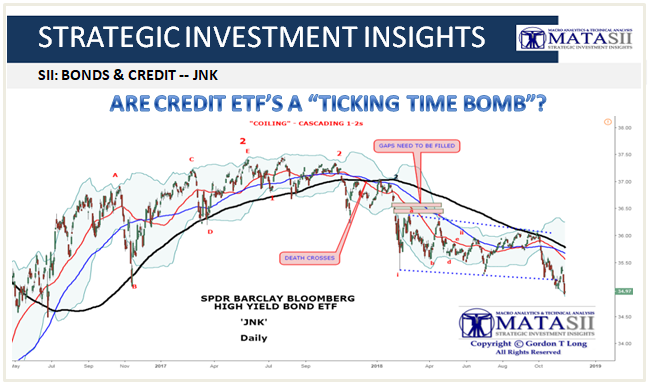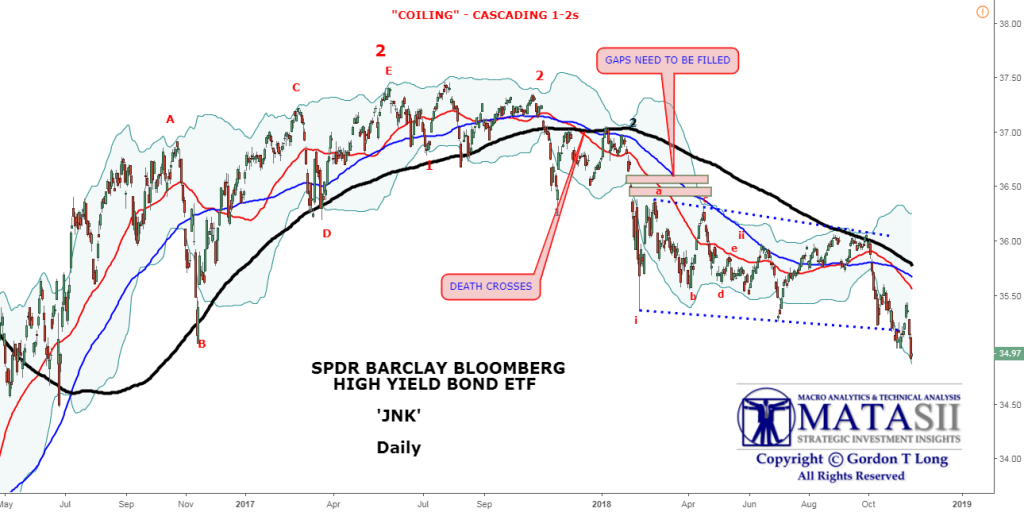THE HEADLINE: Are Credit ETFs A "Ticking Time Bomb"? Here Is JPMorgan's Answer
MATASII SII ANALYSIS:
Gordon T Long's Macro View:
MATASII TAKEAWAYS:
- It was only a matter of time before rising rates kill the easy financing for highly leveraged companies, spurring a wave of bond defaults,
- "The ETF structure isn’t really designed for a large market sell-off. They will break if people don’t trust that they have the liquidity that they think they do today",
- Shorting HYG currently costs over 8% per year on a carry basis: "to short, you pay the ~6.75% underlying bond yield, plus a ~2% borrow cost , less the 0.49% management fee." There are not many LPs who would be willing to shoulder such a high theta in anticipation of a doomsday which may not come for years, which is why Schwartz may be one of a handful of managers who have this trade on - after all, it's his own money his is putting at risk,
- While the bank dismisses the worst case scenario postulated by the bearish hedge fund manager, it also says that it "can't dismiss the very small probability that if enough investors believe the story that these ETFs are a ‘ticking bomb’, their shorting activity could become a self-fulfilling prophecy, even if their views are misguided or self-serving,"
- If JPMorgan's complacent view is wrong - and Schwartz is right - the next time there is a financial crisis driven by a collapse in credit, don't expect the market to reopen for a long, long time,
- The amount of short interest on the HYG junk bond ETF is now the highest on record as many other investors are also convinced the credit ETF day of reckoning is coming.
THE BREAKING NEWS STORY:
Are Credit ETFs A "Ticking Time Bomb"? Here Is JPMorgan's Answer
Are Credit ETFs A "Ticking Time Bomb"? Here Is JPMorgan's Answer
Sunday, November 11, 2018, 4:00 PM
Last week, 39-year-old hedge fund manager Adam Schwartz rekindled the long-running debate over whether credit ETFs are the financial sector's next "ticking time bomb" when as reported, he bet a quarter of his personal money expecting that the next credit crisis would lead to an ETF death spiral.
Picking up on a theme that has been thrown around frequently on Wall Street, ever Since Howard Marks asked in March 2015 "what would happen if credit ETF holders sold all at once", and prompting many other Wall Street icons to warn about the dangers of debt ETFs, Schwartz is so convinced that a "day of reckoning" in fixed income is coming and will hit credit ETFs the hardest, that he has been not only shorting these passive vehicles but layering puts on top.
To Schwartz, it was only a matter of time before rising rates kill the easy financing for highly leveraged companies, spurring a wave of bond defaults. Furthermore, as Bloomberg notes, running a hedge fund with mostly his own cash has allowed Schwartz the freedom to bet on more extreme scenarios, like betting on the very extinction of the product with credit ETFs "perishing in the bloodbath."
Why? Because as he told Bloomberg, "the ETF structure isn’t really designed for a large market sell-off. They will break if people don’t trust that they have the liquidity that they think they do today."
And while many would agree with him, some have also disagreed, and not just the providers and vendors of credit ETFs.
In a note released last Friday titled "Are Credit ETFs a 'Ticking Bomb?'", JPMorgan strategists Bram Kaplan and Marko Kolanovic take offense at Schwartz' assertions and claim that while ETFs would experience collateral damage if a "credit bomb" were to go off, their greater liquidity through the secondary market might leave them less damaged than other alternatives, suggesting that the fundamental thesis of the bearish credit manager who is making a career-defining wager on a collapse in credit ETFs is wrong.
"We disagree with a number of claims in the article, and the implication that the ETF structure is inherently vulnerable", Kaplan and Kolanovic write, while claiming that "in the hypothesized scenario where credit markets freeze, every fund holding these securities will be hit hard and find it difficult to sell portfolio holdings." However, "ETFs have the advantage of offering a secondary market, which provides holders with another avenue to liquidate (without needing to trade the underlying bonds), and may also provide a price-discovery function if the underlying assets aren’t trading." In other words, ETF investors may end up with more, not less, liquidity when the secondary credit market freezes.
“A blow-up in fixed income will hit [ETFs] the hardest” – although the redemption process differs between ETFs and mutual funds (ETFs in-kind vs. mutual funds in-cash), the economics are the same – an investor redemption will ultimately (in most cases) require the liquidation of part of the portfolio. The difference arises from who does the selling – for an ETF, the underlying bonds are typically sold by the market maker, while for a mutual fund it is done by the portfolio manager. In the hypothesized scenario where credit markets freeze, every fund holding these securities will be hit hard and find it difficult to sell portfolio holdings. However, ETFs have the advantage of offering a secondary market, which provides holders with another avenue to liquidate (without needing to trade the underlying bonds), and may also provide a price-discovery function if the underlying assets aren’t trading. For example, in 2015, Greece’s equity market shut down for 5 weeks due to fears the country was about to leave the Eurozone. During that time, GREK (the Global X MSCI Greece ETF) continued to trade actively in the secondary market, in a relatively orderly fashion, and its decline closely reflected the reset lower in Greek stocks when the local market reopened 5 weeks later.
Additionally, despite their strong growth in recent years, total assets in credit ETFs are just ~10% of the size of credit mutual funds. This suggests mutual funds would likely exert much more stress on the underlying market from any fund liquidation/ redemptions in such an event.
The JPM duo also disagrees with the proposed sequence of events when it comes meeting a spike in redemption requests and counters that a "death spiral" would be avoided because even though the redemption basket does not include all bonds in the portfolio, it is "optimized to track the full portfolio, and it is unlikely the ETF manager would structure the basket to include only the most liquid and highly rated securities." Unless, of course, they do.
2. How the ‘rout’ would play out in ETFs – the article claims that ETFs would give away their most liquid securities to facilitate redemptions, leaving the portfolio with only distressed and illiquid bonds, after which APs will stop trading with the fund and send it into a ‘death spiral’. While it’s true the redemption basket for fixed income ETFs usually doesn’t include all bonds in the portfolio, typically the basket is optimized to track the full portfolio, and it is unlikely the ETF manager would structure the basket to include only the most liquid and highly rated securities. By structuring the redemption baskets to include the more liquid securities, the manager would be strongly prioritizing providing liquidity for redemptions over the interests of existing holders. ETF portfolio managers and boards have a fiduciary duty to the ETF and its shareholders (just like mutual funds), and by giving away the highest rated and most liquid securities they wouldn’t be acting in the best interest of remaining shareholders. Rather, in extreme circumstances where the market for corporate bonds becomes distressed and illiquid, the ETF manager is more likely to keep the redemption basket as a representative sampling of the portfolio (i.e. including some illiquid securities) or to temporarily freeze redemptions
So coming back to the original question – are ETFs a "ticking bomb?", JPMorgan's answer is "No", but even the strategist duo admits that they would likely experience collateral damage if a credit ‘bomb’ were to go off, for one simple reason: ETFs, like mutual funds (or indeed any investment portfolio), cannot operate independently of their underlying asset markets, and would likely exhibit signs of stress in a credit market freeze.
The trade off, however, is that in such a doomsday scenario ETFs should, JPM claims, "be more liquid and less impacted than alternatives for the same exposure, given the liquidity available through secondary market trading (however limited that may be in a distressed environment)." Of course, the question is just how "limited" the secondary ETF market would be, or rather, just how much below NAV if it remains the only avenue for sellers to offload exposure and shore up funds.
In its conclusion, JPM then goes full circle and asks if - as Schwartz proposes - shorting credit ETFs a good way to position for a possible collapse of corporate bonds? The bank's answer?
Maybe (if you believe such an event is likely), but no more so than shorting the underlying index (e.g. via swap), and it’s a costly proposition in the meantime."
While one may disagree with JPM's mitigating arguments, JPM's argument about the cost of a short ETF position is spot on: shorting HYG currently costs over 8% per year on a carry basis: "to short, you pay the ~6.75% underlying bond yield, plus a ~2% borrow cost , less the 0.49% management fee." There are not many LPs who would be willing to shoulder such a high theta in anticipation of a doomsday which may not come for years, which is why Schwartz may be one of a handful of managers who have this trade on - after all, it's his own money his is putting at risk.
With all that said, JPM's parting words are rather ominous: while the bank dismisses the worst case scenario postulated by the bearish hedge fund manager, it also says that it "can't dismiss the very small probability that if enough investors believe the story that these ETFs are a ‘ticking bomb’, their shorting activity could become a self-fulfilling prophecy, even if their views are misguided or self-serving."
This is JPM basically saying that even if credit ETFs are ultimately delightful, innocuous products (which they aren't as August 2015 showed very clearly) they will still get annihilated if everyone believes the opposite. As for what happens if JPMorgan's complacent view is wrong - and Schwartz is right - the next time there is a financial crisis driven by a collapse in credit, don't expect the market to reopen for a long, long time.
Finally, it's worth noting which was Wall Street is leaning: as we reported earlier this week, the amount of short interest on the HYG junk bond ETF is now the highest on record as many other investors are also convinced the credit ETF day of reckoning is coming.


